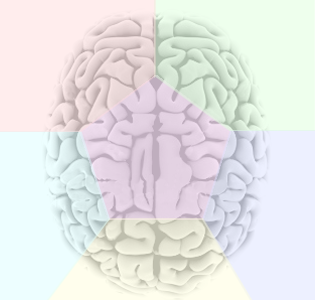More Fat May Be Essential For Your Brain
Fat’s making a comeback! As I noted a few months ago, the latest reviews on fat suggest that not only are natural fats not bad for us, they are essential to brain health. For the past thirty years Americans have been taught to avoid fats and go for the carbs instead, but what has that policy gotten us? We are now fatter with way more diabetes, dementia and heart attacks than ever before. In this article I will review where we went wrong, the most essential fats for the brain. Where they are found, and how these can help us not only think better, but lose weight and stay healthier. [For more info on fats you may also want to see the video at the end from Dr. Noakes at South Africa.]
In the 1950’s Dr Ancel Keys was the man who made it all happen. He postulated that cholesterol, a waxy fat found in many foods and produced by the body, was primarily responsible for the clogged arteries and alarming rise in heart disease. He then set out in his Seven Countries Study to prove that theory. In his special report that made national news, he declared that countries where they had lower saturated fat consumption heart disease rates were also lower. In 1961 the American Heart Association adopted his theory, soon major pharmaceutical companies started cranking out and promoting statins to control this cholesterol and the rest as they say is history.
The only problem is, we now know his hasty theory and strong personality caused a selective bias in his data collection. As a result, his study “was highly flawed” notes Dr. Peter Attia, the president and director of the Nutrition Science Initiative, an independent obesity-research center.1 Now half a century later, with diabetes and dementia reaching epidemic proportions, and just as many dying of heart attacks and strokes, better research is proving the flaws in his theory. Now we see that not only are cholesterol and other fats not bad for us, they are critical for the health of our body and brain.
In my March post on The Cholesterol Hoax I reviewed some of this research noting “absolutely no difference in the risk of dying from coronary artery disease between the high-versus low-cholesterol groups,” and that studied seniors “had much better memory function if they had higher levels of cholesterol!” All fat however is not good for the brain. So in this blog I will share some new insights on 4 essential fats, recently added to the soon to be released 2014 edition of Alzheimer’s May Be Stopped Now! Here’s How.
Why Fats Are Essential
Most everyone knows now that the Omega-3 fats, especially DHA (docosahexanenoic acid) are essential to brain health. DHA appears to be critical for the brain at every stage of development. A lack of DHA in infants has been associated with higher risk for attention deficit disorder, as well as low IQ, and other disorders. In adults low DHA increases risk for post-partum depression and dementia. In one study for example, Alzheimer’s disease was 67% more likely to develop in those whose DHA levels were in the lower half of the distribution.[1] But why? What do these fatty-acids do for our brain? Well, more than you might think. Here is a brief summary. The Omega-3’s:
1. Promote cell membrane integrity and fluidity allowing nutrients in and waste out, and facilitating inter cellular communication – neurotransmission.
2. Enhance cell signaling. which controls not only the cell’s communication with the outside, but also communication within the cell.
3. Reduce inflammation. Inhibits proinflammatory cytokine production, thus greatly reducing inflammation, both systemically and in the brain. This could play a major role in reducing damage generated by a host of disorders such as diabetes, atherosclerosis, autoimmune diseases, and autism, as well as brain aging and other neuro-degenerative disorders.
4. Reduce oxidative stress. Reducing oxidation reduces damage to cells, and thus also reduces inflammation.
5. Improve metabolism and cellular energy. The more fats we burn as energy the fewer we have stored around our waist.
6. Promotes cell growth. They increase brain-derived growth factor, as well as other cellular growth factors, and make up 40% of the new cell structures.
7. Increases PS (phosphatidylserine). Important for memory consolidation – see below.
8. Increase dendrite growth, nerve densityand brain size, all of which increase cognitive reserve and reduce the risk for dementia.
9. Play a role in the regulation of our immune system.
10. Play a role in gene function and expression.
Together these help us not only think better but feel better – less anxious and depressed, as well.
Sources: Cold water fish, wild or sockeye salmon, Pacific Mackerel, tuna in water, sardines, anchovies, Krill and the algae these all feed on. Eggs from free-range or algae fed chickens. DHA can be found in the meat of animals that feed solely on grass or vegetation. Most beef cattle these days spend their last weeks of life on grains and hormones, resulting in lower DHA levels, and higher less healthy visceral fats. Our bodies also have the potential to convert some alpha linolenic acid found in flax, walnuts, chia seeds and other plants into DHA, but not very efficiently. However, these are also helpful.
PS
Phosphatidylserine (PS) Like DHA, PS is a critical components of every cell. Working together they hold together the large molecules that make up our brain cell membranes. Like DHA one of the primary functions of phosphatidylserine is to keep neuronal membranes flexible and permeable, and thus more adaptable. It also helps to reduce the stress hormone cortisol.[2] Improved membrane function and reduced cortisol means less resistance to insulin, and therefore improved energy production.[3] And fewer calories stored as belly fat.
In patients who had advanced-stage Alzheimer’s disease, PET scans revealed that, after taking 500 mg of phosphatidylserine every day for 3 weeks, every study participant showed significantly enhanced glucose metabolism across all brain regions, compared to baseline scans.[4] Improved metabolism means more energy for thinking and remembering – and less going into adipose storage.
Furthermore, PS facilitates the accumulation, storage and release of various neurotransmitters, including acetylcholine (which you will recall, is used to make memories), thereby improving cell-to-cell communication.[5]
Sources are limited. PS is made in the brain from DHA. Otherwise it is found in the brains of fish and healthy animals, but also may be found in soy lecithin. If lacking in the brain PS is available as a supplement. EurOmega is a special supplement made from wild salmon brain in Norway that contain both bioavailable DHA and PS.
Choline
This is best known for it’s role in the production of the neurotransmitter acetylcholine (ACh) . ACh is the primary neurotransmitter of memories. Acetylcholine is used by the brain in long-term planning, concentration, communication and focus. It also controls the rate of stimuli entering the brain, even during sleep and sex. It does this by strengthening the so-called stimulus barrier, making it possible to sleep through minor noises and other disturbances. We know that a lack of sleep can lead to memory problems, but this could be a symptom of insufficient choline in the brain as well. Additionally Ach impacts motor activity, as well as learning and memory.
In addition to promoting this molecule of memory, choline is essential in repairing and maintaining nerve cells. It also nourishes the fat-like sheaths that insulate neurons, axons and dendrites called myelin. When neurons don’t have sufficient myelin they are more prone to dysfunction as in multiple sclerosis. Moreover choline also aids in the regulation of cholesterol, as well as the metabolism of fats, and therefore, the generation of energy used to fuel the body and brain cells. [6] For that reason many athletes consume foods or supplements high in choline to help maintain their energy over time. If not they may end up suffering symptoms of a choline deficiency. Supplementing with choline may be a good practice to promote mental energy as well.
Moreover, like DHA, choline is essential to maintain receptor cites that receive neuro-transmisions. More than 40 percent of the fats in brain synapse membranes consist of choline; and finally there is evidence that choline production also contributes to the body’s DHA (docosahexaenoic acid) pool.[7]
Choline also aids in a process called methylation which protects brain cells from aging, and in the synthesis of adenosylmethionine (SAMe), one of our brains most crucial methylators, brain protectors and mood enhancers.
As we age our brain’s ability to make and uptake circulating choline tends to decrease, while enzymes that degrade acetylcholine increase. This typically results in a decline in synaptic junctions, dendrite branches, and in levels of the neurotransmitter acetylcholine. In Alzheimer’s disease, the levels of acetylcholine are abnormally low. It is the cholinergic neurons that show the most degeneration as Alzheimer’s disease progresses. This resulting deficiency and decline is widely recognized as one of the primary causes of age-related memory and cognitive decline.
Sources: The 2005 National Health and Nutrition Examination Survey stated that only 2% of postmenopausal women consume the recommended intake for choline.[8] Good sources include eggs (from range free chickens), shrimp, most fish, cod, salmon, Tilapia, kidney bean, baked beans, Spinach, asparagus, collard greens, chard, Brussel spouts, broccoli, cauliflower, chicken, tofu, tomato sauce, peas, sunflower seeds, amaranth, almonds, peanuts, wild rice and milk.
Much of the choline we eat, however, does not make it to the brain. The liver and other organs need it as well. So over the years a great deal of effort has gone into trying to come up with forms of choline that are more readily assimilated across the blood brain barrier. Phosphatidylcholine from soy lecithin was one of the first shown to be effective. Since then CDP or Citi-coline and Alpha GPC or (glyceryl phosphoryl) choline have been shown to be of significantly greater value for increasing choline concentrations in the brain.[9] It is interesting to note that a quart of fresh cows milk contains about 250 mg of GPC choline. Since newborn mammals have a tremendous need for choline.
Cholesterol
Cholesterol is an essential structural component of animal cell membranes. It is required to maintain both membrane structural integrity and fluidity. Some have described it as the “glue” that holds our cells together. Additionally, Cholesterol also enables animal cells to change shape and move about – adapt[10]
Dr. Perlmutter notes, that it also “acts as an antioxidant and a precursor to important brain supporting elements like vitamin D, as well as the steroid-related hormones (e.g., sex hormones such as testosterone and estrogen). Most important, cholesterol is looked upon as an essential fuel for the neurons.”[11] Keep in mind, in the studies noted in The Cholesterol Hoax, higher cholesterol in seniors was associated with better memories.
Sources: Our body can produce most if not all of the cholesterol it needs from the other fats noted above. This is usually generated in response to stress or damage to our cells. If more is needed it is available in eggs and most saturated fats.
Caution: All fats are not created equal. TRANS fats from hydrogenated or partially hydrogenated oils, and boiled or deep fried fats have been altered in ways that make them hard for our body and brain to break down. They make for weak and rigid cells, which are easily diseased, and inhibit the good essential fats noted above from entering your brain. So avoid the TRANS fats at all costs if you want a healthy brain.
Also most Omega-6 from processed vegetable oils, especially soy, peanut, corn, and canola oil should be avoided as well. Coconut oil on the other hand is likely the best for cookings, and olive oil the best for salad’s etc.
Danger: Excess refined sugars, causes the oxidation of fats, making them harmful for our bodies, this we now know is one of the primary causes of oxidation and inflammation in the body, heart and vascular disease and age related cognitive decline, as well as Alzheimer’s.
So make sure you get these good fats in your diet. Avoid the bad ones. And see the difference it can make in both your mind and your body! Talking about seeing – these fats are also essential to healthy vision.
Email me for more information on how to obtain the best forms of these in supplement forms at a discount.
For a video on a related insights you may want to watch Professor Tim Noakes, MD from South Africa’s. He doesn’t have a political or economic bias. But does have some great info: See it here: https://www.youtube.com/watch?v=vdrEiu6aaVM
References
1. As quoted by Brain Walsh in Eat Butter, Time, June 23, 2014.
[1] Kyle DJ, Schaefer E, et al. Low serum docosahexaenoic acid is a significant risk factor for Alzheimer’s dementia. Lipids. 1999;34(suppl):S245.
[2] http://www.lef.org/magazine/mag2004/jul2004_report_cortisol_02.htm
[3] Heiss WD, Kessler J, Mielke R, Szelies B, Herholz K. Long-term effects of phosphatidlyserine, pyritinol, and cognitive training in Alzheimer’s disease. A neuropsychological, EEG, and PET investigation. Dementia. 1994 Mar-Apr;5(2):88-98.
http://www.lef.org/magazine/mag2005/oct2005_report_brain_01.htm?source=search&key=phosphatidylserine%20insu
[4] Klinkhammer P, Szelies B, et al. Effect of phosphatidylserine on cerebral glucose metabolism in Alzheimer’s disease. Dementia. 1990;1:197-201.
[5] Kidd, P. Phosphatidylserine: A Remarkable Brain Cell Nutrient. Decatur, IL: Lucas Meyer, Inc. 1997.
[6] http://www.lef.org/abstracts/codex/choline_index.htm?source=search&key=choline
[7] http://en.wikipedia.org/wiki/Choline
[8] Leslie M Fischer, Kerry-Ann da Costa, Lester Kwock, Joseph Galanko, and Steven H Zeisel (2010). “Dietary choline requirements of women: effects of estrogen and genetic variation”. American Journal of Clinical Nutrition 92 (5): 1113–1119.
[9] http://www.lef.org/magazine/mag2002/sep2002_cover_gpc_01.htm
[10] http://en.wikipedia.org/wiki/Cholesterol
[11] Perlmutter, (2013) p. 41
Prevention Strategies 








- FREE SPECIAL REPORT AND UPDATES
For free monthly updates on the latest practical research related to brain health and memory improvement, and a free 23 page report on How to Prevent or Arrest Alzheimer's, Click here. Recent Comments
Archives
- July 2019
- November 2018
- September 2018
- July 2018
- June 2018
- April 2018
- February 2018
- January 2018
- December 2017
- October 2017
- September 2017
- August 2017
- June 2017
- May 2017
- March 2017
- January 2017
- December 2016
- October 2016
- September 2016
- August 2016
- June 2016
- May 2016
- April 2016
- March 2016
- February 2016
- January 2016
- December 2015
- November 2015
- August 2015
- July 2015
- June 2015
- May 2015
- April 2015
- March 2015
- February 2015
- January 2015
- November 2014
- October 2014
- September 2014
- August 2014
- July 2014
- June 2014
- April 2014
- March 2014
- February 2014
- January 2014
- December 2013
- November 2013
- October 2013
- September 2013
- August 2013
- July 2013
- June 2013
- June 2012
- February 2012
- January 2012





